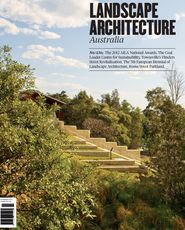China has a strong history of garden design, which has developed as an art form over millennia and is still visible in the retained and restored gardens dotted throughout the country. Yet garden design does not equal the modern definition of landscape architecture. And despite China’s garden-design roots, landscape architecture matching the distinction of its gardens is lacking.
Historically, China’s leaders have never been afraid of big or bold projects. The physical results of many, especially those woven into the landscape fabric of China, still remain visible to this day. The Great Wall slithering over mountain ridges north of Beijing, the Grand Canal, snaking its way between Beijing and Hangzhou, and the terracotta warriors of emperor Qin Shi Huang lined up in defence of their leader dwarf any landscape gesture of the modern era, anywhere.
Yet it is modern landscape gestures that we are (or should be) passionate about, even if they will never quite compare to the Great Wall. So why are so few pushing any boundaries? What has changed in the modern era that sees so few inspiring projects being realized?
When comparing the Australian and Chinese real estate markets the question becomes even more complex. Here in Australia both labour and materials are far more expensive than in China, and the demand for real estate is weakening, yet we see a determined effort by developers to provide the latest and greatest, biggest and boldest, smartest and sexiest landscapes as a selling point for their developments. In China the demand for real estate is still extreme, in comparison, so Chinese developers have far more revenue to invest, yet they too rarely push the boundaries.
A WiFi garden.
Image: Courtesy Marc Deuschle
In general there are a few very simple explanations, and although the obvious answer appears to be increased profits, it goes a little deeper than that. Most simply, there is a distinct lack of originality among Chinese developers. Developers have the attitude that safe is best, where safe means to do what your competitor does but charge a fraction less. The theory is that if a competitor sells units for twenty thousand yuan per square metre, and we sell for 19,500 yuan per square metre, the buyers will naturally buy the cheaper product. Sadly, this leads to what we find in every major real estate market in China – an oversupply of uninspiring high-rise developments surrounded by poorly designed and under-equipped gardens (not landscapes).
The value and potential of a well-designed landscape is not well understood by Chinese developers, and especially not by their marketing departments. This is almost ironic in a country where the use of public landscape is so established, extensive and varied. From before sunrise to late at night Chinese parks are full of groups singing, dancing, practising tai chi, engaging in sword or ribbon dancing, playing with oversized yoyo-esque toys, flying kites, exercising on state-supplied equipment, playing cards and games, or just strolling and sitting while watching others. Whatever the activity, China seems to have a fundamental connection to the landscape. Perhaps developers think since well-programmed landscape exists in the public realm private developments do not require it.
All elements took on the imagery of motherboard circuitry.
Image: Courtesy Marc Deuschle
Interestingly, projects that are more adventurous are often very popular. For decades China has allowed architects – mostly foreign – to experiment on its skylines, with sometimes wonderful, often ridiculous, but always thought-provoking results.
Invariably each new town and city now being planned in China – and there are many – strives to establish itself using a landmark building. Architectural design has evolved to a stage where the “point of difference” is seen as a positive. Even in more established cities like Shanghai and Beijing, buildings like The World Financial Center (Shanghai), the CCTV Tower and Water Cube (both in Beijing) and the Bird’s Nest (China’s National Stadium), are obvious examples of this new outlook.
Great landscape architecture does exist in China. The New Botanic Garden Shanghai, by Valentien + Valentien Landscape Architects, and Shanghai Houtan Park (part of Shanghai Expo 2010) by Turenscape, are two outstanding recent examples.
When it comes to residential landscape architecture the general approach is a little more conservative, although occasionally a bolder project appears. One example is Pixel in Beijing, a large residential development ten kilometres from the centre of the city. The building concept by Sako Architects (Tokyo) resembles oversized pixel grids, and the landscape design was conceived with the aim of matching this boldness while also creating a development full of excitement and program for residents. The landscape was inspired by a computer’s motherboard; its componentry “scaled up” to become functioning landscape elements such as pathways, walls, furniture, lighting and a folly bridge.
“Fallen pixels” form landscape structures.
Image: Courtesy Marc Deuschle
The project proved so popular that the selling price jumped from fourteen thousand yuan per square metre to twenty-eight thousand yuan per square metre once interest grew. Unfortunately, for each interesting idea there are dozens that follow the uninspiring formula. So where does the future of Chinese residential landscape architecture lie?
It was only recently that landscape architecture became a stand-alone degree in China, and the first graduates only began to emerge in the early 2000s. Together with returned foreign-taught practitioners they are now establishing themselves in both locally owned and foreign-owned design offices. Hopefully their design experimentation and confidence will increase and see them initiate new directions. It is hard to believe that Chinese landscape architecture will not undergo a considerable evolution in the coming years.
We can only hope that in the future, as more and more projects with a useful, exciting, contextual and contemporary landscape prove successful, buyers will demand such standards as the minimum, and that this will lead to a permanent mental shift in the minds of developers.
Source

Discussion
Published online: 15 Apr 2013
Words:
Marc Deuschle
Images:
Courtesy Marc Deuschle
Issue
Landscape Architecture Australia, November 2012






















